Medical expert of the article
New publications
Preparations
Antibiotics after a tick bite for adults and children for treatment and prevention
Last reviewed: 03.07.2025

All iLive content is medically reviewed or fact checked to ensure as much factual accuracy as possible.
We have strict sourcing guidelines and only link to reputable media sites, academic research institutions and, whenever possible, medically peer reviewed studies. Note that the numbers in parentheses ([1], [2], etc.) are clickable links to these studies.
If you feel that any of our content is inaccurate, out-of-date, or otherwise questionable, please select it and press Ctrl + Enter.
Tick-borne infections are the cause of many life-threatening diseases. Let's consider which antibiotics are most effective for tick bites, when and how to use them.
Ticks are potential carriers of microbes and several types of viruses. The most famous diseases transmitted by insects are: tick-borne encephalitis, borreliosis (Lyme disease), anaplasmosis. Medicine knows about 60 pathologies transmitted by these parasites. The group of tick-borne infections includes:
- Tick-borne relapsing fever.
- Tularemia.
- Babesiosis.
- Ehrlichiosis.
- Hemorrhagic fever.
- Tsutsugamushi disease.
- Rickettsiosis.
- Spotted fever.
- Marseille fever and others.
The most dangerous is encephalitis, that is, inflammation of the brain, which can lead to death.
Insect attacks are seasonal. The first bites occur in early spring, and the last ones in late autumn. The maximum number of lesions is recorded from mid-spring to the first months of summer. The tick attaches to an animal or a person using a hypostome (a special organ) and injects its saliva. At the site of attachment, inflammation and a local allergic reaction develop due to microtrauma. The attached parasite remains unnoticed for a long time. Bites are most often localized in places with a developed capillary system and delicate skin (groin, armpits, ears, abdomen, lower back, chest).
It is worth noting that not every tick is a carrier of diseases. Most infections, thanks to the immune system, do not cause infectious damage. The bite is not accompanied by pain, which is why the attached insect can remain unnoticed for a long time. Pathological symptoms appear after 2-4 hours and depend on the individual characteristics of the human body and the number of attached parasites.
The main symptoms of the lesion:
- Increased weakness and drowsiness.
- Chills.
- Photophobia.
- Aches in the joints.
- Nausea and vomiting.
- Dizziness and headaches.
- A sharp drop in pressure.
- Increased heart rate.
- Itching and rashes on the body.
- Enlargement of regional lymph nodes.
The most pronounced symptoms are observed in elderly people, in the presence of chronic diseases, allergic reactions or immunodeficiency states, as well as in children. Very often, recurrent fever is observed. The temperature rises 2-4 days after the bite, lasts for about 2-3 days, after which it returns to normal.
Antibiotics for tick bites are taken to prevent infectious contamination. The choice of drug, dosage and duration of treatment should be done by a doctor. In addition, it is the doctor who should pull out the insect and send it for examination.
Antibiotic treatment after a tick bite
To date, there is no single protocol for the treatment and prevention of tick-borne infections. Antibiotic treatment after a tick bite is carried out to prevent its consequences and complications. This is due to the fact that insects are carriers of many viruses and infectious agents. To protect against tick-borne encephalitis, you can get vaccinated, but this will not save you from other diseases caused by the parasite.
In most cases, the bite that caused the infection is visible after 30 minutes to 1 hour. The affected area becomes bright red with pronounced swelling. Erythema gradually appears, the redness has clear boundaries (a thin circle with a large diameter). Such signs indicate infection with Lyme spirochetes. Taking antibacterial drugs is aimed at stopping the infection and the symptoms of this disease.
Drug treatment consists of:
- Antibacterial therapy
Since ticks carry infectious diseases that manifest themselves in skin reactions, tetracycline series drugs are effective antibiotics for their treatment: Tetracycline, Doxycycline, Amoxicillin. If, against the background of skin manifestations, there are symptoms of damage to the nervous system, heart or joints, then penicillin or cephalosporin antibiotics are prescribed: Penicillin, Ampicillin, Ceftriaxone. In case of intolerance to the above drugs, macrolides are used, for example, Erythromycin.
Antibacterial treatment is carried out with the use of probiotics, which restore beneficial microflora in the digestive organs, necessary for normal digestion and absorption of food. Their use is due to the fact that, together with the infection, antibiotics destroy beneficial bacteria living in the gastrointestinal tract. Most often, patients are prescribed Linex or Bifiform.
- Detoxification
The main cause of tick-borne borreliosis is poisoning of the body with endotoxins released by the infectious agent. Detoxification therapy consists of taking detoxification drugs (Atoxil, Albumin) and drinking plenty of fluids with vitamin C.
- Symptomatic and restorative treatment
It is aimed at suppressing painful symptoms and improving the patient's condition. In case of severe pain syndrome and elevated temperature, NSAIDs are used: Naproxen, Indomethacin, Paracetamol, Ibuprofen, Nurofen. Antihistamines are indicated for stopping allergic reactions: Diazolin, Suprastin, Alleron, Claritin. Immunostimulants are prescribed to stimulate the immune system: Immunal, Timogen or Imudon. Immunosuppressants are indicated for severe disorders of the nervous system. Vitamins of groups A, B, E have general strengthening properties.
Physiotherapy is used as an additional treatment method. It is aimed at normalizing blood circulation at the site of the bite and restoring the functioning of the peripheral nervous system, eliminating inflammation in the joints. The most commonly used physiotherapy procedures are: electrophoresis, UV irradiation, magnetic therapy, massage, paraffin applications.
If necessary, 3-4 months after infection from a tick bite, a repeat course of treatment is carried out with intravenous administration of antibiotics and immunomodulators.
Indications antibiotics after a bite
All indications for the use of antibiotics for tick bites are based on the symptoms of pathologies that occur during infection. The first sign of an insect attack is reddening of the tissues at the site of the bite. If borrelia (Lyme disease pathogens) have entered the skin, the affected area swells, and red rings appear around the bite, resembling a target drawn on the body. This erythema is migratory, so it can move to other parts of the body.
In most cases, a bite from a blood-sucking tick leads to Lyme disease, which requires antibiotics to treat. This pathology has three stages, each with its own characteristic symptoms, let's look at them:
Stage I
The symptoms of tick-borne infestation begin to develop after the incubation period, that is, after 2-3 days. During this time, the infection has already begun to spread throughout the body and poison it with endotoxins. The duration of this stage is from 3 days to a month. During this period, symptoms appear that are already an indication for the use of antibiotics:
- Significant increase in the size of annular erythema.
- Swelling, pain and itching in the affected area.
- A sharp increase in body temperature, feverish state.
- Body aches, muscle stiffness.
- Enlargement of regional lymph nodes.
- Sore throat and cough (may be mistaken for signs of a cold).
- General malaise, weakness.
- Headaches.
- Nausea and vomiting.
- Various rashes on the body.
In rare cases, about 20% of patients do not have the above symptoms. They only have annular erythema. But this does not mean that the disease has stopped developing, since borreliosis can take a latent form for a while.
 [ 1 ], [ 2 ], [ 3 ], [ 4 ], [ 5 ], [ 6 ]
[ 1 ], [ 2 ], [ 3 ], [ 4 ], [ 5 ], [ 6 ]
Stage II
Occurs 1-3 months after infection, occurs in 15% of patients who did not seek timely medical care at the first stage of the disease. This stage is characterized by the penetration of infection into the lymphatic and circulatory system, internal organs, central nervous system, heart. Main symptoms:
- Increased weakness and malaise.
- Photophobia.
- Frequent pulsating headaches, dizziness.
- Sleep and concentration disorders.
- Stiffness of the occipital muscles.
- Depressive state.
- Hearing impairment.
- Facial nerve paralysis.
- Angina pectoris, arrhythmia.
- Pericarditis.
- Meningitis.
- Cervicothoracic radiculitis.
Stage III
It begins 6-24 months after infection. It manifests itself as a chronic course of the disease with the following symptoms:
- Joint damage (osteoporosis, arthritis).
- Disorders of the nervous system.
- Weakness and malaise.
- Migraines and severe headaches.
- Paroxysmal pain in the abdomen and joints.
- Frequent bouts of nausea.
- Changes in the blood picture (increased leukocytes and ESR).
- Memory disorder.
- Convulsive syndrome.
- Disability.
This stage occurs in approximately 10% of people when bitten by a tick.
To prescribe antibacterial and other drugs, a diagnosis of the disease is carried out. For this, the doctor collects anamnesis, that is, asks the patient about the case of an insect bite and how much time has passed since that moment. A general and biochemical blood test, serological reactions, radiography, immunofluorometry, PCR testing, and an electrocardiogram are prescribed. A skin biopsy with tissue sampling from the surface of the erythema is mandatory.
Release form
Antibiotics used for tick bites come in various forms. At the first stage of treatment or prevention, oral forms are used: tablets, capsules, suspensions, solutions. Such drugs are quickly absorbed and absorbed, but can be destroyed when they enter the acidic environment of the gastrointestinal tract.
At the second stage of therapy, when laboratory diagnostics have confirmed the presence of a tick-borne infection, medications are prescribed for intramuscular and intravenous administration. This category includes ready-made ampoules with injections and dry substance (powder) for the preparation of an injection solution.
There are also antibiotics in the form of ointments, gels, drops, that is, for local use. But when affected by ticks, they are used extremely rarely.
Names of antibiotics and other medications after a tick bite
To prevent infectious complications after a tick bite, antibiotics are recommended. Let's look at the names of the most effective and popular drugs:
A broad-spectrum antibiotic, belongs to the macrolide group. When it enters the body, it creates high concentrations in the affected area, exerting a bactericidal effect.
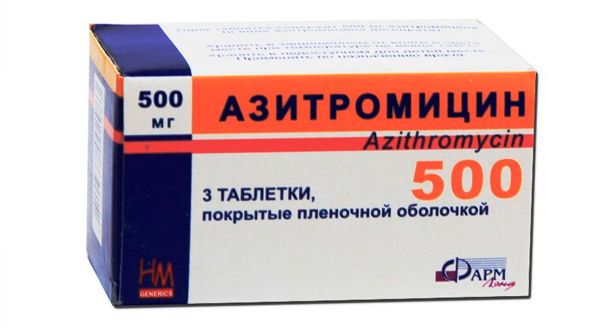
- Indications for use: various infectious diseases caused by harmful microorganisms sensitive to the drug. Infections of the upper and lower respiratory tract and ENT organs, infectious lesions of the skin and soft tissues, diseases of the genitourinary tract, borreliosis (Lyme disease).
- Method of administration: the medicine is taken one hour before meals or two hours after. On average, one dose per day of 250-500 mg is prescribed. For the treatment of acute symptoms caused by a tick bite - twice a day at 500 mg and 250 mg from the second to the fifth day of therapy.
- Side effects: nausea and vomiting, flatulence, abdominal pain, increased activity of liver enzymes, skin rashes.
- Contraindications: individual intolerance to the components of the drug, severe renal dysfunction. Pregnancy and lactation, allergic reactions to the drug in the anamnesis.
The drug is available in the form of tablets, capsules and syrup for oral administration.
- Augmentin
A broad-spectrum antibacterial agent. Has bacteriolytic properties. Contains the active substance - clavulanic acid, which ensures the drug's resistance to the effects of beta-lactamases and expands its spectrum of action.
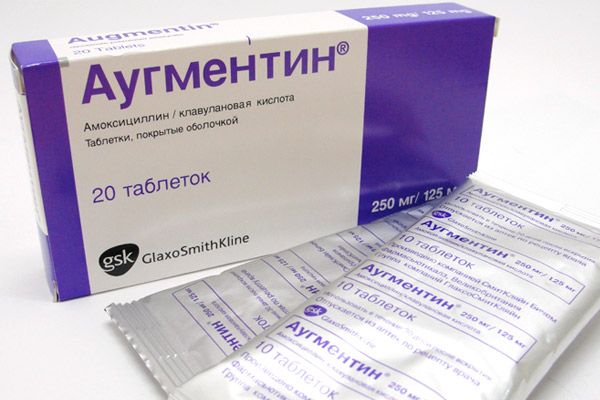
- Indications for use: bacterial infections caused by microorganisms sensitive to the drug. Used for infectious diseases of the upper respiratory tract, bacterial lesions of the skin and soft tissues. For infections of the genitourinary system, sepsis, septicemia, postoperative infections, osteomyelitis, peritonitis.
- The method of administration and dosage are determined individually for each patient. The maximum single dose is 1.2 g, the permissible daily dose for intravenous administration is 7.2 g. Before taking the drug, it is important to determine the sensitivity of the microflora that caused the disease to it.
- Side effects: digestive disorders, liver dysfunction, hepatitis, cholestatic jaundice, skin allergic reactions, urination disorders, candidiasis, inflammation of the vein at the injection site.
- Contraindications: intolerance to the components of the drug, severe liver dysfunction, erythematous rash, urticaria, pregnancy and lactation.
Augmentin is available in tablet form, as a syrup in vials and as a dry substance for the preparation of a suspension and drops, and as a powder for injections.
- Bicillin-5
Beta-lactam antibiotic from the penicillin group. Its antimicrobial action is similar to benzylpenicillin. Does not accumulate in the body, is low-toxic, and has a prolonged effect.
- Indications for use: infections caused by microorganisms sensitive to the drug, prevention of rheumatism.
- Method of administration: for adults 1,500,000 IU once a month intramuscularly, for pediatric patients 600,000 IU once every 3 weeks.
- Side effects are manifested by skin allergic reactions. The main contraindication is intolerance to the components of the drug.
Release form: dry substance for preparation of injections, in vials of 1,500,000 U.
Interferon-generating agent, alpha and beta interferon inducer. Has anti-inflammatory and immunostimulating properties. Particularly effective against tick-borne encephalitis virus and the causative agent of hemorrhagic fever with observed renal syndrome (HFRS).
- Indications for use: prevention and treatment of tick-borne encephalitis, HFRS
- Directions for use: tablets should be taken after meals. Single dose 100-300 mg 2-3 times a day. The course of treatment is from 2 to 9 days.
- Side effects: skin rash, dyspepsia, angioedema. In case of overdose, increased side effects are observed.
- Contraindications: hyperthyroidism, liver and kidney failure, pregnancy and lactation, pediatrics, halogen intolerance.
Iodantipyrine is available as tablets for oral use.
- Clarithromycin
An antibacterial agent from the macrolide group, a semi-synthetic derivative of erythromycin.
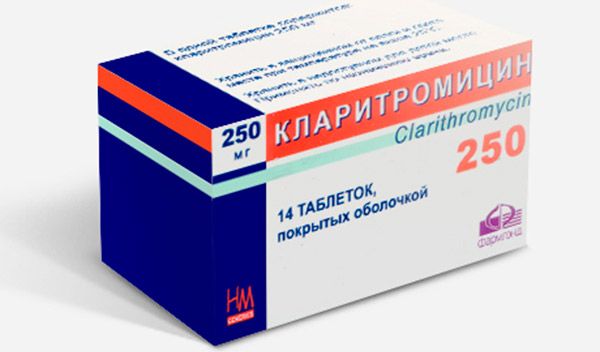
- Indications for use: treatment and prevention of infectious processes caused by flora sensitive to the drug. Effective in infections of the upper respiratory tract, skin and soft tissues. Infectious lesions of the dental and jaw system, various local infections. Also used in complex therapy for the eradication of Helicobacter infection.
- Method of use: the medicine can be taken regardless of food. On average, patients are prescribed 500 mg 2 times a day. The course of therapy is 5-14 days.
- Side effects: vomiting, stomatitis, nausea, taste disturbances, headaches and dizziness, hallucinations, tachycardia, skin allergic reactions, hypoglycemia.
- Contraindications: patients under 12 years of age, hypersensitivity to the components of the drug, first trimester of pregnancy.
- Overdose: nausea, vomiting, diarrhea. Treatment is symptomatic, hemodialysis is ineffective.
Clarithromycin is available in film-coated tablets containing 500 and 250 mg of active substance.
A chemotherapeutic agent with pronounced antiviral activity. In the early stages of infection, it inhibits viral replication and slows down the synthesis of the viral membrane.
- Indications for use: prevention of tick-borne viral encephalitis, early treatment and prevention of influenza in children and adults.
- Directions for use: It is recommended to take the tablets after meals with water. To prevent tick-borne infections, the drug should be taken immediately after an insect bite. Adults are prescribed 100 mg twice a day for 3-5 days, for children the dosage is individual in each individual case.
- Side effects: diarrhea, vomiting, drowsiness, impaired concentration, tinnitus, hoarseness, allergic skin rashes, paresthesia.
- Contraindications: chronic and acute kidney disease, pregnancy and lactation, thyrotoxicosis, intolerance to the components of the drug.
Remantadine is available in tablet form, with one capsule containing 50 mg of the active substance.
- Sumamed
A broad-spectrum antibiotic, belongs to macrolides. After entering the body, it creates high concentrations in the inflammation site, has bactericidal properties.
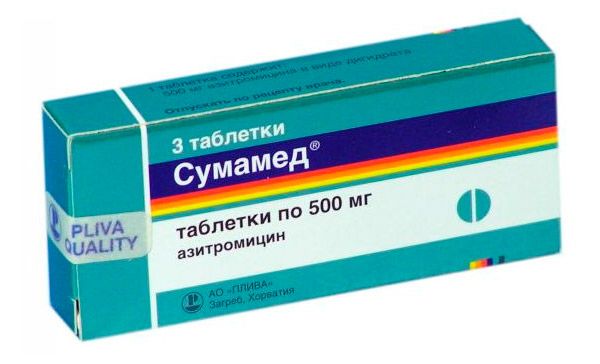
- Indications for use: upper respiratory tract and ENT infections, bacterial and atypical pneumonia, bronchitis. Skin and soft tissue infections, secondary infected dermatoses, Lyme disease, inflammation of the urethra.
- Directions for use: once daily 500 mg one hour before meals or two hours after meals. The duration of treatment is determined by the doctor.
- Side effects: nausea and vomiting, flatulence, increased activity of liver enzymes, skin rashes.
- Contraindications: hypersensitivity to macrolide antibiotics, severe renal and hepatic dysfunction, history of allergic reactions to the drug, pregnancy and lactation.
- Overdose: nausea, vomiting, diarrhea, temporary hearing loss. Treatment is symptomatic, gastric lavage is recommended.
The drug is available in tablet form and in vials with powder for the preparation of suspension or syrup.
Antibacterial agent for internal and external use. Has a broad spectrum of action against many harmful microorganisms.
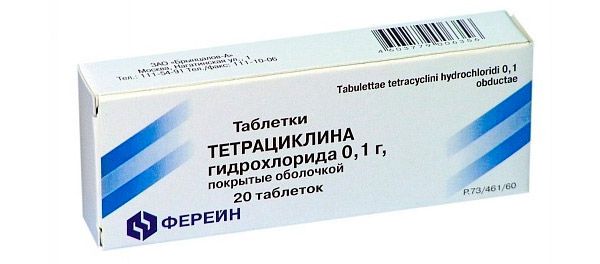
- Indications for use: pneumonia, bronchitis, purulent pleurisy, inflammation of the internal cavities of the heart, bacterial and amoebic dysentery, tonsillitis, gonorrhea, brucellosis, tularemia, relapsing fever. Infectious lesions of the urinary tract, purulent meningitis. The drug can be used for infectious lesions of the eyes, phlegmon, mastitis, gonorrhea, cholera, septic conditions.
- Method of administration: 250 mg every 6 hours, the duration of treatment depends entirely on the severity of painful symptoms.
- Side effects: decreased appetite, nausea, vomiting, intestinal dysfunction, skin allergic reactions, photosensitivity, changes in the mucous membranes of the oral cavity and gastrointestinal tract.
- Contraindications: hypersensitivity to the components of the drug, fungal diseases, kidney diseases, leukopenia, pregnancy, childhood.
It is available in the form of tablets, dragees, granules for the preparation of syrup and suspension for oral administration.
An antimicrobial agent from the second-generation cephalosporin group. It produces a bactericidal effect by binding to penicillin-binding proteins on the walls of bacteria. It has an optimal spectrum of action against gram-positive and gram-negative microorganisms.
- Indications for use: infectious diseases of the respiratory tract and ENT organs, skin and soft tissue lesions. Prescribed for infectious and inflammatory processes of the musculoskeletal system and urogenital tract.
- Method of administration: the average therapeutic dose for adults is 250 mg twice a day. The course of treatment is selected by the doctor, individually for each patient.
- Side effects: bowel disorders, dyspeptic symptoms, headaches and dizziness, hearing loss, vaginitis, drowsiness, convulsions, increased liver enzymes.
- Contraindications: pregnancy and lactation, bleeding of any etiology.
- Overdose: convulsions, increased nervous excitement. Gastric lavage and intake of sorbents are indicated for treatment.
A semi-synthetic antibiotic from the third-generation cephalosporin group. It has a broad spectrum of action and is used for parenteral administration.
- Indications: lower respiratory tract infections, urinary tract lesions, bone and soft tissue infections, abdominal organs. The drug is effective in Lyme disease and for the prevention of postoperative infections and complications.
- Method of administration: administered intramuscularly and intravenously, by jet and drip. Dosage and course of treatment depend on the characteristics of the patient's body and the severity of the disease.
- Side effects: allergic skin reactions, nausea, vomiting, bowel disturbances, abdominal pain, leukopenia, hemolytic anemia, arrhythmia, headaches, phlebitis.
- Contraindications: hypersensitivity to the components of the drug, bleeding, pregnancy and lactation, impaired renal and hepatic function.
- Overdose: skin allergic reactions, encephalopathy, dysbacteriosis. Treatment is symptomatic.
The drug is available in the form of powder for injection in vials with a dosage of 500 mg, 1 and 2 g.
List of antibiotics for tick bites in adults
If an infection is detected during laboratory testing of a tick removed from the skin, then drugs are prescribed to prevent it, that is, to prevent further development. An antibiotic for a tick bite in adults is used if there are characteristic pathological symptoms. Most often, victims experience skin manifestations of the bite - migratory erythema, that is, a Lyme borreliosis spot. The temperature rises, and other symptoms similar to a flu infection appear. In this case, it is necessary to immediately begin a course of antibiotic therapy.
Most often, when bitten by a tick, adults are prescribed the following antibiotics:
- Amoxicillin
A bactericidal agent from the group of semi-synthetic penicillins. Has a broad spectrum of action. Acid-resistant, quickly and completely absorbed.
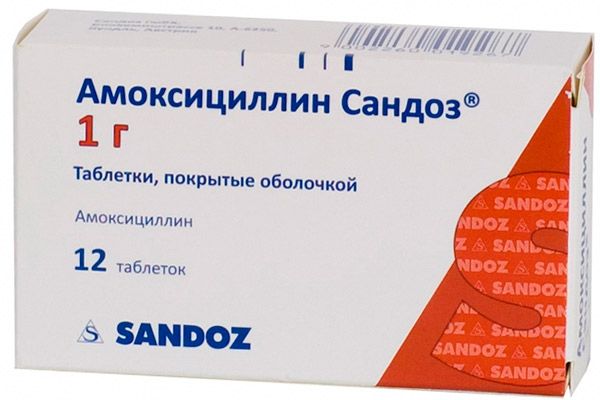
- Indications for use: bacterial infections, pneumonia, inflammation of the kidney tissue and renal pelvis, inflammatory lesions of the urethra and small intestine, other infections caused by microorganisms sensitive to the drug.
- The method of administration and dosage are determined individually for each patient and depend on the severity of the infection and the sensitivity of the pathogen. Adults are prescribed 500 mg 2-3 times a day; in severe cases of the disease, the dosage can be doubled.
- Side effects: skin allergic reactions, inflammation of the mucous membrane of the nose and the outer membrane of the eye, a sharp increase in temperature, pain in the joints. In rare cases, the development of superinfection is observed.
- Contraindications: penicillin intolerance, infectious mononucleosis. Prescribed with special caution during pregnancy, with a tendency to allergic reactions.
The drug is available in several forms: enteric-coated tablets, capsules, solution and suspension for oral use, dry substance for injection.
- Doxycycline
A semi-synthetic antibiotic from the pharmacotherapeutic group of tetracyclines. It has a broad spectrum of action and bacteriostatic properties. After oral administration, it is quickly absorbed from the gastrointestinal tract. The maximum concentration in the blood plasma is observed two hours after administration. The level of binding to plasma proteins is 80-95%. The half-life is 15-25 hours.
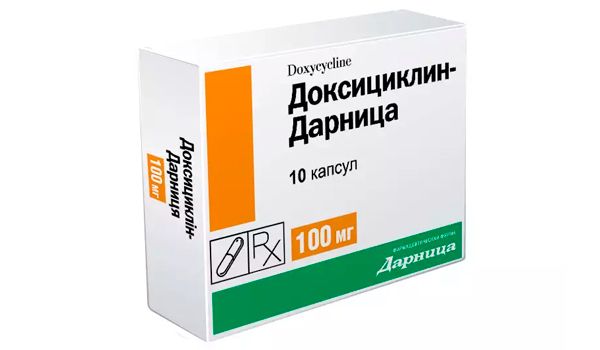
- Indications for use: various infectious and inflammatory diseases caused by intracellular pathogens and microorganisms sensitive to the drug. The drug is used for treatment and prevention of tick bites, borreliosis, gastrointestinal infections, ENT organs, urinary tract, pelvic organs, lower respiratory tract. Effective for prostatitis, first stage Lyme disease, whooping cough, syphilis, tularemia, cholera and other diseases.
- Method of administration: the medicine is taken orally after meals, with water (to reduce irritation of the esophagus). The daily dose can be taken at once or divided into two doses (every 12 hours). For most infections, 200 mg of the drug is prescribed, with the dosage reduced to 100 mg in the following days. The course of treatment is 10-14 days.
- Side effects: nausea, vomiting, abdominal pain, allergic reactions and edema. With prolonged use of the drug, neutropenia, hemolytic anemia, candidiasis, dysbacteriosis, persistent changes in tooth enamel are possible.
- Contraindications: hypersensitivity to tetracyclines and doxycycline, second half of pregnancy, lactation, porphyria, leukopenia, severe liver failure.
Available in capsule form for oral use.
- Claforan
An antimicrobial agent from the cephalosporin group. Contains the active substance cefotaxime (third-generation cephalosporin). Has pronounced bactericidal properties. Resistant to most beta-lactamases.
- Indications for use: treatment of diseases caused by microorganisms sensitive to cefotaxime. Most often used for infectious diseases of the musculoskeletal system, soft tissues, skin, respiratory and urogenital systems. Effective for septicemia, bacteremia, diseases of the nervous system, intra-abdominal infections.
- Method of administration: the medication is used to prepare a solution for intravenous and intramuscular injections. Subcutaneous or intradermal administration is contraindicated. For adult patients with most diseases, a single intramuscular injection of 500-1000 mg is prescribed. For severe diseases, the administration of 2 g of the drug is indicated at intervals of 6-8 hours and a daily dose of 6-8 g.
- Side effects: neutropenia, arrhythmia, thrombocytopenia, encephalopathy, nausea and pain in the epigastric region, vomiting, allergic reactions, anaphylactic shock.
- Contraindications: intolerance to the components of the drug and other medications from the cephalosporin group, pregnancy and lactation.
- Overdose: High doses may cause reversible encephalopathy. There is no specific antidote. Treatment involves discontinuing the drug and symptomatic therapy.
The drug is available in powder form in transparent glass bottles for the preparation of an injection solution.
- Minocycline
A semi-synthetic antibiotic from the tetracycline group. It has a broad spectrum of action and prevents bacterial growth.
- Indications for use: bacterial infections, infectious diseases of the upper or lower respiratory tract, ornithosis, psittacosis, Reiter's syndrome, conjunctivitis, trachoma, plague, tularemia, cholera, brucellosis, tick-borne relapsing fever, soft tissue and skin infections, meningococcal infections.
- The method of administration and dosage are individual for each patient. The average initial dose is 200 mg followed by a dose of 100 mg every 12 hours. Treatment should last 24-48 hours.
- Side effects: loss of appetite, nausea, vomiting, difficulty swallowing, increased sensitivity of the skin to sunlight, skin allergic reactions, increased activity of liver enzymes, headaches and dizziness.
- Contraindications: intolerance to tetracyclines, pregnancy, childhood.
The drug is available in tablet form, capsules and oral suspension.
- Realdiron
Immunomodulator, antiviral and antiproliferative agent. Stimulates cellular activity of phagocytes and T-cells.
- Indications for use: diseases of viral etiology, hepatitis B, C, tick-borne encephalitis, cutaneous T-cell lymphoma, Kaposi's sarcoma, malignant melanoma, renal cell carcinoma, chronic myeloleukemia.
- Method of administration: the drug is used for parenteral administration, i.e. intramuscularly or subcutaneously. The medicine must be diluted in 1.0 ml of water for injection. In case of a tick bite, 1–3 million IU is prescribed twice a day for 10 days. Then the therapy is continued with the administration of 5 injections of Realdiron at 1–3 million every 2 days.
- Side effects: general weakness, chills, fever, increased sleepiness, headaches, myalgia. Leukopenia, thrombocytopenia develop extremely rarely, liver dysfunction and arrhythmia are also possible. Overdose is manifested by more intense side effects.
- Contraindications: individual intolerance to the components of the drug. Use during pregnancy is possible if the expected benefit to the mother is higher than the potential risks to the fetus.
Realdiron is produced as a lyophilisate (dry powder) for injection.
- Rovamycin
Macrolide with bacteriostatic effect. Active against intracellular pathogens. Biotransformed in the liver, forming active metabolites. Excreted with bile and urine.
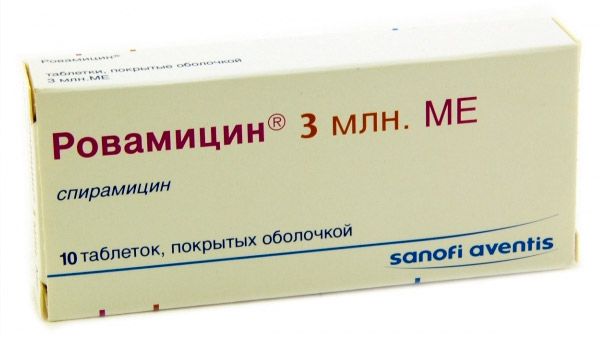
- Indications for use: ENT diseases, bronchopulmonary pathologies, skin lesions, genitourinary diseases, sexually transmitted infections.
- The method of administration and dosage depend on the form of the drug and the indications for use. In most cases, 3 million IU are prescribed 2-3 times a day (daily dose 6-9 million IU). The course of treatment is 3-5 days, but if necessary, it can be extended to 10 days.
- Side effects: allergic reactions, nausea, vomiting, pseudomembranous colitis, paresthesia, phlebitis, pain in the epigastric region, increased transaminase levels.
- Contraindications: intolerance to the components of the product, severe liver damage, lactation. The drug is allowed to be used during pregnancy.
- Overdose: nausea, vomiting, bowel disorders, cardiovascular disorders of varying severity. There is no specific antidote, symptomatic therapy is indicated.
Rovamycin is available in several forms: film-coated tablets (1.5 and 3 million IU), lyophilized powder for injection.
A third-generation cephalosporin antibiotic. Characterized by bactericidal properties due to the inhibition of bacterial cell wall synthesis. Has a broad spectrum of antimicrobial action.
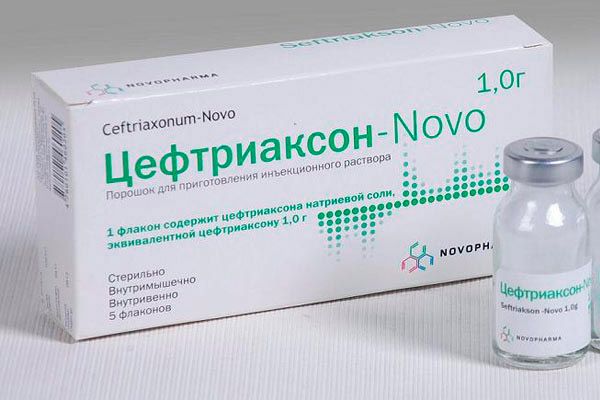
- Indications for use: infectious diseases caused by microorganisms sensitive to the drug, infections of the ENT organs, upper and lower respiratory tract, infectious lesions of the skin and soft tissues. Infections of the genitourinary organs, abdominal cavity. Bone infections, Lyme disease (develops after a tick bite), syphilis, chancroid, typhoid fever, salmonellosis. Prevention of postoperative purulent-septic pathologies.
- Method of administration: the medicine is used intramuscularly/intravenously and only freshly prepared solutions. Adult patients and children over 12 years of age are prescribed 1-2 g per day, if necessary, the dosage can be increased to 4 g. The duration of therapy depends on the severity of the infection and the patient's condition.
- Side effects: nausea, vomiting, diarrhea, hepatitis, allergic reactions, hematopoietic system disorders, candidiasis, phlebitis, pain at the injection site.
- Contraindications: individual intolerance to the drug and other cephalosporins or penicillins, first trimester of pregnancy and lactation, renal and hepatic insufficiency.
- Overdose: Long-term use of the drug may cause blood picture disorders (leukopenia, hemolytic anemia, neutropenia). Treatment is symptomatic, hemodialysis is not effective.
The medication is available in the form of powder for preparation of injection solution.
A second-generation cephalosporin antibiotic. The semi-synthetic drug has bactericidal properties against a wide range of harmful microorganisms. Inhibits the synthesis of bacterial cell membrane peptide glycan. Penetrates the transplacental barrier and into breast milk.
- Indications for use: diseases of the upper respiratory tract, diseases of the ENT organs, cystitis, pyelonephritis, gonorrhea, arthritis, bursitis, osteomyelitis, furunculosis, erysipelas, pyoderma, various infectious pathologies, diseases of the abdominal cavity and gastrointestinal tract.
- Method of administration: the drug is used for intravenous or intramuscular administration. Adult patients are prescribed 750 mg every 8 hours. The course of treatment is individual for each patient.
- Side effects are extremely rare and reversible. Most often, patients experience the following reactions: neutropenia, leukopenia, nausea, vomiting, bowel disorder, headaches and dizziness, increased excitability, increased levels of creatine and urea in the blood serum. Skin and local allergic reactions.
- Contraindications: individual intolerance to the components of the drug, cephalosporins and penicillins. The drug is not recommended during pregnancy and lactation.
- Overdose: increased excitation of the central nervous system, convulsions. Treatment is symptomatic, hemodialysis or peritoneal dialysis is possible.
Cefuroxime is available in the form of powder for preparation of injection solution.
- Emsef
A broad-spectrum antibiotic. Contains the active ingredient ceftriaxone, a substance with antimicrobial properties and belongs to the cephalosporin group. When administered intramuscularly, its bioavailability is 100%. The active ingredients penetrate the cerebrospinal fluid, pass through the placental barrier, and are excreted in breast milk.
- Indications for use: infections of the abdominal cavity, respiratory tract, kidneys, joints, bones, soft tissues, genitals and urinary tract. Infectious lesions of patients with reduced immunity, sepsis, meningitis, early and late stages of disseminated Lyme borreliosis.
- Method of application: the prepared solution is administered by jet or drip. For patients over 12 years old, 1-2 g is prescribed at intervals of 24 hours. In case of severe infections, the daily dose may be increased to 4 mg. Therapy should last for 48-72 hours after the patient's condition has returned to normal. In case of a tick bite, the antibiotic is taken for 14 days.
- Side effects: stomatitis, pancreatitis, diarrhea, nausea and vomiting, neutropenia, leukopenia, hematuria, reversible cholelithiasis, secondary fungal infections. Allergic and local reactions (phlebitis, pain along the vein) are also possible. Overdose is manifested by more pronounced side effects. There is no specific antidote, symptomatic treatment is indicated.
- Contraindications: history of hypersensitivity to penicillins or cephalosporins. Prescribed with caution to people with renal failure. Safety of use during pregnancy has not been studied, the drug can penetrate the placental barrier.
Emsef is available in the form of powder for the preparation of a solution for parenteral administration.
An antibiotic from the tetracycline group, contains the active substance doxycycline. It has bacteriostatic properties, is active against pathogenic microorganisms in the functional stage of growth and division.
- Indications for use: infectious diseases of the ENT organs, upper and lower respiratory tract, gastrointestinal tract, genitourinary system. The drug is effective in gonorrhea, pyelonephritis, cystitis, prostatitis, skin and soft tissue infections, typhus.
- The method of administration, dosage of the drug and duration of treatment are determined by the attending physician individually for each patient. Adults are usually prescribed 200 mg once a day or 100 mg twice a day. For severe infectious diseases, 200 mg is prescribed daily.
- Side effects: nausea, vomiting, disturbances of appetite and stool, hemolytic anemia, headaches and dizziness, increased intracranial pressure, erythema, photosensitivity, various allergic reactions, candidal infections.
- Contraindications: hypersensitivity to the components of the drug and medications from the pharmacotherapeutic group of tetracyclines, pregnancy and lactation, patients under 8 years of age.
- Overdose: nausea, vomiting, diarrhea, headaches and dizziness. There is no specific antidote, so gastric lavage, intake of enterosorbents and further symptomatic therapy are indicated.
Unidox is produced in tablet form, that is, for oral use.
On average, the course of treatment/prophylaxis with antibiotics for tick bites is 10-28 days. For pregnant women and people with weakened immunity, the duration of treatment can be 6-8 weeks. Short-term use of antibiotics is useless and dangerous for the body, as it promotes increased reproduction of borrelia. At the same time, it is strictly contraindicated to interrupt the therapy that has been started. If side effects occur, that is, the drug is not suitable, then it is replaced with other antibiotics that are equally effective.
Pharmacodynamics
Various pharmacological effects, mechanism of action, strength and localization of medicinal substances in the body after their use - this is pharmacodynamics. Antibiotics prescribed for tick bites should have a broad spectrum of action.
First of all, patients are prescribed drugs of the penicillin or cephalosporin group, and if they are intolerant, tetracyclines or macrolides. When entering the body, the antibacterial agent creates high concentrations that destroy protein compounds and cells of harmful microorganisms.
Pharmacokinetics
The processes of absorption, distribution, metabolism and elimination of drugs from the body are pharmacokinetics. Most antibiotics used to prevent and treat tick-borne infections are rapidly and completely absorbed, regardless of their release form. They are characterized by high bioavailability and increased concentration in the blood plasma over a short period of time.
An effective antibacterial drug has a prolonged effect, penetrates into all organs and body fluids. That is why many antibiotics are contraindicated during pregnancy and lactation. The elimination period, on average, takes about 5-8 days. Active components and their metabolites can be excreted by the kidneys in the form of urine, bile or during defecation.
Dosing and administration
Before prescribing any medication, it is necessary to determine the sensitivity of the microflora that caused the disease in a given patient. The method of administration and doses of antibiotics are selected by the doctor, individually for each case.
In case of a tick bite, medications may be prescribed for both oral and intramuscular/intravenous administration. In the latter case, only freshly prepared solutions should be used. The duration of therapy depends on the severity of the pathological symptoms and the characteristics of the patient's body. Most often, treatment lasts from 10 days to 1-3 months.
Use antibiotics after a bite during pregnancy
A tick bite during pregnancy is of particular concern, as there is very little information about borreliosis and the impact of tick-borne infections on the fetus. Medicine has recorded isolated cases of transmission of pathogens through the placenta, and only in animals.
The pathological effect of infection on a growing organism is based on the similarity of the pathogen with pale treponema or syphilis. Clinical and epidemiological studies have not confirmed the relationship between a tick bite and a negative pregnancy outcome (miscarriages, birth of children with developmental disabilities). Also, transmission of infection during lactation, i.e. through breast milk, has not been confirmed.
The use of antibiotics during pregnancy for the treatment or prevention of tick-borne infections is possible only with a doctor's prescription. For this, the woman must have characteristic symptoms or serological confirmation of infection. Most often, expectant mothers are prescribed a course of the following drugs: Amoxicillin, Abiclav or Rovamycin. Antibiotics should be taken with special caution, as some of them can cause complications during pregnancy.
Contraindications
Antibiotics, like other types of medications, have certain contraindications for use. Let's take a closer look at the cases in which antibacterial treatment of tick-borne infections can be difficult:
- Individual intolerance to the active substance and other components of the drug.
- Pregnancy and lactation.
- Newborns, children and elderly patients.
- Severe renal or hepatic impairment.
- Leukopenia.
Antibiotics are prescribed with special caution to patients who have a history of allergic reactions to this drug.
Side effects antibiotics after a bite
In some cases, the use of antibacterial drugs causes side effects. Most often, patients experience the following reactions:
- Nausea and vomiting.
- Disruption of stool.
- Intestinal dysbacteriosis.
- Transient increase in liver transaminase activity.
- Changes in blood picture.
- Various allergic reactions (itching, skin rash, swelling).
- Urinary retention or frequent urination.
- Candidiasis.
In addition to the above symptoms, local reactions are possible: with intravenous administration - phlebitis, and with intramuscular use - pain at the injection site.
Overdose
High doses or prolonged use of antibiotics can cause overdose symptoms. Most often, patients experience the following reactions:
- Changes in the blood picture (leukopenia, hemolytic anemia, neutropenia).
- Dysbacteriosis.
- Encephalopathy.
- Skin allergic reactions.
- Increased nervous excitement.
In most cases, there is no specific antidote, so symptomatic treatment is indicated. Desensitizing drugs, hemodialysis or peritoneal dialysis may be used.
Interactions with other drugs
Complex treatment and prevention of tick-borne infections is much more effective than monotherapy. But in this case, possible interactions with other drugs should be taken into account. For example, Cephalosporin, when used with drugs that reduce platelet aggregation, significantly increases the risk of bleeding. The use of this drug with anticoagulants leads to increased anticoagulant action. And diuretics increase the risk of nephrotoxic reactions.
Interaction of Doxycycline with antacids or magnesium-containing laxatives provokes the formation of poorly soluble compounds. Cholestyramine or Colestipol reduce the absorption of the active components of the drug. While barbiturates reduce its half-life. A similar reaction is observed with regular alcohol consumption and treatment with Doxycycline.
Storage conditions
The antibiotic's form of release determines its storage conditions. All forms of medications should be kept in their original packaging, protected from sunlight, moisture and out of reach of children. The recommended storage temperature for tablets is no higher than +25°C, and for ready-made injections +10-15°C. Failure to comply with these conditions may lead to premature deterioration of the drug and loss of its medicinal properties.
Shelf life
Timely use of antibiotics for tick bites helps to minimize the risk of tick-borne infections. Medications can only be taken as prescribed by a doctor, following all of his recommendations. Particular attention should be paid to the expiration date of medications, since expired medications can cause uncontrolled side effects, which will significantly worsen the patient's condition and his chances of successful recovery.
Attention!
To simplify the perception of information, this instruction for use of the drug "Antibiotics after a tick bite for adults and children for treatment and prevention" translated and presented in a special form on the basis of the official instructions for medical use of the drug. Before use read the annotation that came directly to medicines.
Description provided for informational purposes and is not a guide to self-healing. The need for this drug, the purpose of the treatment regimen, methods and dose of the drug is determined solely by the attending physician. Self-medication is dangerous for your health.

